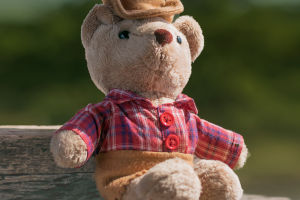"More than twenty years ago, a pure and kind-hearted boy named John, fearing the loneliness of having no friends, made a wish that his beloved teddy bear could come to life and become his true friend. Some mysterious force made his wish come true. John and the teddy bear lived together, enjoying a joyful childhood."
This is the plot introduction of the movie "Teddy Bear," a simple film about a boy longing for companionship, bestowed with life by his plush toy.
There are countless movies related to stuffed toys. And at different stages of human growth, stuffed toys replace different roles.
The fascination with stuffed toys usually begins in childhood
In the research conducted by child psychologists such as Richard Passman at the University of Wisconsin, it was found that children's attachment to stuffed toys or soft objects, known as "transitional object attachment," is a universal phenomenon worldwide.
During a significant period after birth, children often perceive themselves as one with their mothers. However, as children gradually grow, and become psychologically independent, they become aware of the differences between themselves and their parents. At this point, children may attribute maternal characteristics to a certain object in their environment, gradually achieving self-soothing.
In psychology, this process is known as transitional object attachment, and the item children choose to attach to is often a soft plush toy or a small blanket. It's rare for children to form attachments to hard objects.
Touching soft things tends to make people feel comfortable and secure, much like a mother's embrace and kisses. The majority of children choose plush toys because of the character or animal traits attributed to them. As they age, transitional object attachment gradually weakens.
Even as adults, our love for stuffed toys merely fades over time, but for some people, their attachment to stuffed toys not only doesn't wane but grows stronger. The intensity of this obsession may depend on its frequency of presence in their lives.
The Fairy Tale World of Adulthood - "The Companion of The Growing Years"
For some people, it's no longer just an item filled with cotton and fabric, but a companion who stays by their side through thick and thin.
It's often said that everyone has a teddy bear in their heart, one that replaces the love missing from childhood, one that replaces the troubles and pains of growing up, fulfilling the inner emptiness for a long time.
Amidst the myriad troubles of the real world - compared to a lover who might leave at any moment, a job that might be lost, or a bank account that might be depleted at any time - a quietly sitting plush toy that never leaves, provides warmth and satisfaction. They name their beloved toys, imagining a life together with them.
Some people enjoy picking up old, worn-out stuffed dolls from junkyards, washing and repairing them, and displaying them in showcases; some choose to marry their plush toys and invite friends to attend the wedding.
The usefulness of plush toys is also becoming more widespread. In the Netherlands, it's mandated that all police cars carry two teddy bears. Their cute appearance can provide comfort and companionship when people are injured or helpless.
Plush toys are objects onto which people project their spirit, emotions, and feelings. Due to physiological characteristics and family environments, young children find it difficult to express and describe their various emotions and feelings. At this time, a "silent" doll with unchanging expressions becomes an appropriate object for them to comfort themselves and project various imaginations onto.
For mature, socialized adults, although various objects for projection exist in the real world, plush toys still play an important role, serving as objects or substitutes for emotional projection. Therefore, the value of plush toys varies from person to person, and the stronger the desire to project onto them, the more their value is recognized.


